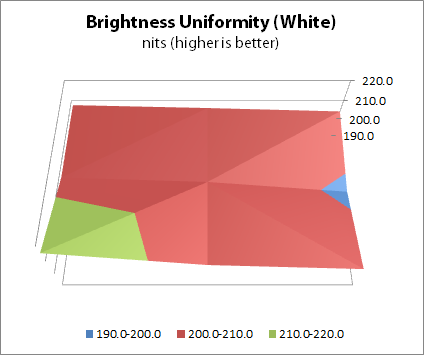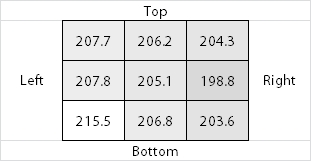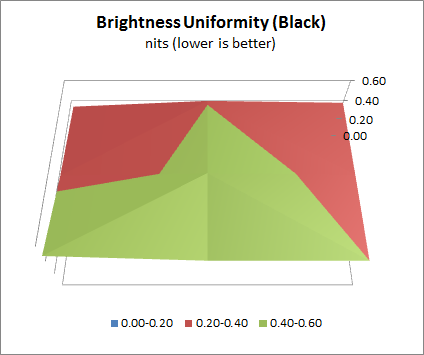NEC PA301w: The Baddest 30-inch Display Around
by Brian Klug on March 1, 2011 8:00 AM ESTBrightness Uniformity
For brightness uniformity, we test at the same 9 points we measure Delta-E on, but this time measure white and black levels when the center point is as close to 200 nits as we can get. We use the same colorimeter and software as before, - an Xrite i1D2 and ColorEyes Display Pro. Similar to the ordinary brightness test (taken at the center), contrast is set to 100 in the OSD and brightness is set to as close to 200 as possible in the center before measurements are taken.
White Uniformity


Black Uniformity


It appears that the PA301w's built-in uniformity settings help keep the brightness profile very steady in the full on white test. There's a tiny horizontal dependence from left to right, but it's imperceptible in practice, and the standard deviation of these readings is just 4 nits. Uniformity in the white department is actually very good.
Blacks are a little worse, again the bottom left seems to be brighter than the rest of the display by a measurable and consistent amount. On the whole again though the consistency is pretty good. Displaying a purely black image, there's also no obvious light leakage anywhere on the display.










92 Comments
View All Comments
AceHoleGoober - Thursday, March 3, 2011 - link
$2,000+ LCD and it is not 120hz? Not worth the money despite the other features.ganeshts - Saturday, March 5, 2011 - link
Brian,Thanks a lot for adding the custom refresh rates testing results.
They look promising, and I assume the OSD for the refresh rate is only accurate to 1 decimal place. So, 29.97 gets rounded up to 30, 23.976 to 24, but 59.94 is only 59.9 :)
It will be interesting to see whether these refresh rates are supported in any of the cheaper LCD models.
How does the display treat video content? Particularly, how is the display of interlaced content at native and non-native refresh rates. It is quite interesting to me, but I would also like to know whether any of the other readers think it is an aspect worth reporting on.
anonapon - Sunday, March 6, 2011 - link
Like ganeshts, I, too, am very interested in how it does with video, but only a little in how it does with interlaced content. Mostly, I'm interested in how it would compare to a high-end HDTV when playing high definition progressive media, such as a standard Blu-ray movie.I'm trying to put a new system together which can function as both a workstation and HTPC (and gaming rig, but I'm not as concerned with color quality there), and the extra pixels of a 2560 x 1600 display would be very valuable to me when I'm using the system as a workstation, but I'm also looking for great video playback, and if I could find one device which could provide both, I would gladly pay the price premium for an NEC or Ezio over the HP or Dell 30", as it would be saving me from using an actual HDTV and sacrificing much workspace.
My personal reference points are the Sony HX909 and Panasonic VT-25, because those are the ones I am familiar with from when I was looking into HDTVs (at which point I could hear a tiny voice shouting "Pixels! Pixels!"), but information relating to the NEC or Ezio (or HP or Dell) to any TV would be helpful because I could then compare that TV to the ones I know.
If there is a review of the Ezio 30", I'd really appreciate it if some information about video playback was included. I assume, with all of the attention to color accuracy of the NEC and Ezio, that their performance is very good, equal or close to that of a high-end HDTV, but I'd rather not assume.
bleucharm28 - Thursday, March 10, 2011 - link
$2299 wowMattShan - Friday, March 11, 2011 - link
Thanks for this test of a high-end display. Even if one is not in the market for a pro-caliber device, it is very useful to see how consumer-/prosumer-level devices compare to it.I just heard today from a reputable source that EIZO plans to eventually replace its 30-inch 2560x1600 monitors with 27-inch 2560x1440 models, which feature nearly the same resolution in a more compact (and much lighter weight) package. 30-inchers are simply too big and massive for most people and require moving one's head side to side too much; 27 inches should be a better overall solution for most. AnandTech already has tested the two 27-inch monitors by Dell and Apple. Can you please test NEC's 2560x1440 entry in this blossoming market segment, the PA271W? It has received positive reviews from others, but your methodology is more rigorous and needs to be applied to this model. EIZO also has two 27-inch 2560x1440 models being released this month, the FlexScan SX2762W and ColorEdge CG275W; a joint test of those two models also would be great. It will be interesting to see which is best--NEC or EIZO (or maybe Dell).
ycoty - Monday, March 14, 2011 - link
Hi,Can someone tell me if its possible to use this display with a 13"macbook pro july 2009.
Thank you
aislepathlight - Wednesday, April 6, 2011 - link
Hey allI was pondering the 27 inch version of this display. Would the review for this apply, in most part, to that screen?
Thanks!
Klaipedietis - Friday, April 8, 2011 - link
Helloi just bought it, and noticed a pretty significant backlight bleeding, starting from TOP MIddle to right top corner , and noticed the exact same one bleeding is in one of pictures of yours
at NEC PA301w Viewing Angle Gallery in the very first black screen picture
just wandering if all units got the same issue about BLB ??
State of the Art Monitor - Saturday, May 7, 2011 - link
For those who are in the cost no object SOTA game, video and computer users:http://pro.sony.com/bbsc/ssr/cat-monitors/cat-visu...
Maybe AnandTech could get one from Sony for a test run?
prime2515103 - Friday, May 27, 2011 - link
Is there a particular reason you don't find LED backlighting in high-end displays? Is there a downside to LED that I missed?Thanks